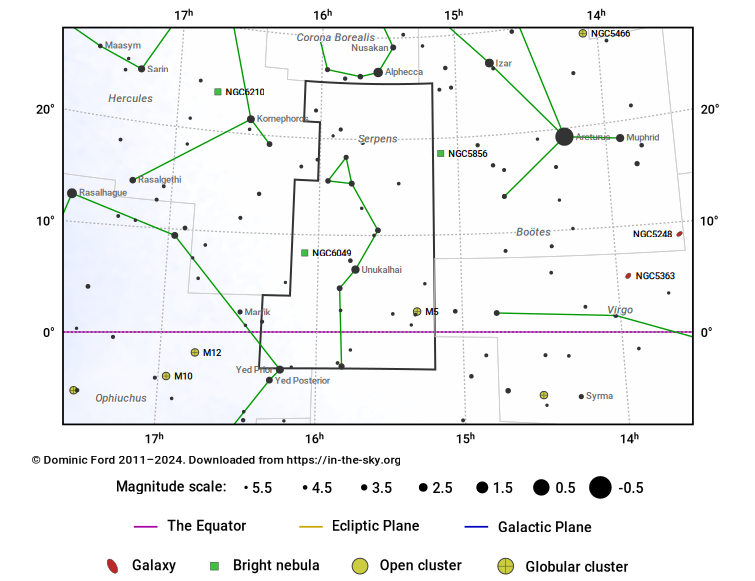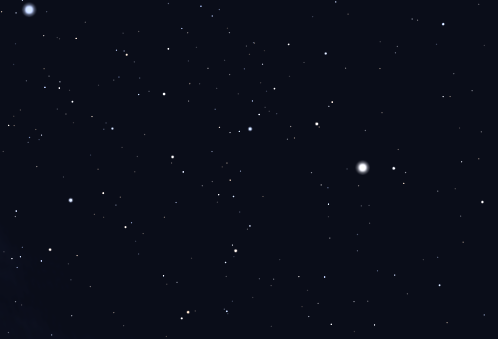The Constellation Serpens Caput
Serpens is unique among the constellations in that it is divided into two separate pieces which are considered part of the same constellation.
It represents a snake which is usually depicted either wrapped around the waist of Ophiuchus the serpent bearer, or else wrapped behind his back.
When Eugène Delporte came to define the modern constellation boundaries in the 1920s, he faced the problem of how to separate the serpent and serpent-bearer into two separate constellations, and he opted to split the serpent into two parts.
Serpens is an equatorial constellation which appears highest in the evening sky in the months around June.
Both the head of the snake, Serpens Caput, and the tail of the snake, Serpens Cauda are represented by third and fourth magnitude stars
The head of the snake is well separated from the Milky Way, and contains no bright deep sky objects. The tail of the snake, however, not only lies close to the plane of the Milky Way, but also neighbors Sagittarius, the constellation which contains the galaxy's center. It is home to several bright open clusters and globular clusters.
Serpens is not the only snake in the night sky, and neither is it the largest. The largest of all the constellations is Hydra, the water snake, which also has a smaller and fainter companion in the far-southern sky, Hydrus.
Ancient
1.5% of the sky
636.9 square degrees
Serpens Caput contains no Caldwell objects
Hover the pointer over the name of an object to highlight its position on the starchart to the right, or click to see more information.
| Stars | Open Clusters | Globular Clusters | Galaxies |
| Unukalhai (mag 2.6) | Messier 5 (mag 5.7) | NGC 5921 (mag 11.0) | |
| μ-Ser (mag 3.5) | NGC 5962 (mag 11.5) | ||
| β-Ser (mag 3.6) | NGC 5970 (mag 11.6) | ||
| ε-Ser (mag 3.7) | NGC 6118 (mag 11.7) | ||
| δ-Ser (mag 3.8) | NGC 6070 (mag 11.8) | ||
| γ-Ser (mag 3.9) | NGC 5964 (mag 11.8) | ||
| κ-Ser (mag 4.1) | NGC 6012 (mag 12.0) | ||
| δ-Ser (mag 4.1) | NGC 5957 (mag 12.2) | ||
| λ-Ser (mag 4.4) | NGC 6027 (mag 12.4) | ||
| ι-Ser (mag 4.5) | NGC 5936 (mag 12.5) | ||
| ρ-Ser (mag 4.7) | NGC 6020 (mag 12.7) | ||
| π-Ser (mag 4.8) | NGC 5996 (mag 12.8) | ||
| σ-Ser (mag 4.8) | NGC 5954 (mag 12.8) | ||
| MQ Ser (mag 5.1) | IC 1151 (mag 12.9) | ||
| b-Ser (mag 5.1) | NGC 6051 (mag 13.0) | ||
| TYC933-1239-1 (mag 5.1) | NGC 6021 (mag 13.0) | ||
| 10-Ser (mag 5.2) | NGC 5937 (mag 13.1) | ||
| τ¹-Ser (mag 5.2) | IC 1158 (mag 13.1) | ||
| ω-Ser (mag 5.2) | NGC 6023 (mag 13.1) | ||
| 16-Ser (mag 5.3) | NGC 6010 (mag 13.2) | ||
| χ-Ser (mag 5.3) | IC 4553 (mag 13.2) | ||
| 3-Ser (mag 5.3) | NGC 6007 (mag 13.2) | ||
| A²-Ser (mag 5.4) | NGC 5980 (mag 13.2) | ||
| HIP 79195 (mag 5.4) | NGC 5956 (mag 13.3) | ||
| 6-Ser (mag 5.4) | NGC 5984 (mag 13.3) | ||
| HIP 77902 (mag 5.5) | NGC 5953 (mag 13.3) | ||
| A¹-Ser (mag 5.5) | NGC 5990 (mag 13.3) | ||
| φ-Ser (mag 5.5) | NGC 6003 (mag 13.4) | ||
| HIP 77163 (mag 5.6) | NGC 6004 (mag 13.4) | ||
| 4-Ser (mag 5.6) | NGC 6018 (mag 13.4) |




